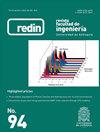聚羟基烷酸酯支架的形态、机械强度和降解
IF 0.5
Q3 ENGINEERING, MULTIDISCIPLINARY
Revista Facultad De Ingenieria-universidad De Antioquia
Pub Date : 2018-05-05
DOI:10.19053/01211129.V27.N48.2018.8073
引用次数: 0
摘要
组织工程(TE)旨在改善不理想的植入物发展和医疗程序,以解决骨和软骨损伤。TE旨在利用细胞生长平台(支架)再生组织,这些平台可能由天然聚合物如聚羟基烷酸酯(PHA)组成。PHA是一种创新材料,由于其降解能力和细菌来源,可以大规模生产和控制最终性能,因此在医疗应用中非常有用。在这项研究中,我们利用冻干技术和因子实验设计开发了商业化的PHA支架。以二氯甲烷为PHA溶剂,特吉糖醇为表面活性剂,液氮(n2)为冷冻剂。采用傅里叶红外光谱(FTIR)和热重分析(TGA)对PHA进行了表征;并对支架进行扫描电镜(SEM)和机械压缩及水解降解试验。PHA的表征表明,该材料是PHA和聚乳酸(PLA)的混合物。结果表明,支架具有适合软骨细胞迁移的孔隙分布,并且具有与关节软骨相似的行为,尽管其机械强度较低。此外,支架的质量损失与样品中PHA的百分比呈非线性关系。总之,PHA支架在组织工程中修复关节软骨具有潜在的应用前景。本文章由计算机程序翻译,如有差异,请以英文原文为准。
Morphology, mechanical strength and degradation of polyhydroxyalkanoate scaffolds
Tissue engineering (TE) seeks to improve the unsatisfactory development of implants and medical procedures to solve bone and cartilage injuries. TE aims at regenerating tissues using cell growth platforms (scaffolds), which may consist of natural polymers such as polyhydroxyalkanoate (PHA). PHA is an innovative material useful in medical applications due to its degradation capability and bacterial origin that allows large-scale production and control final properties. In this research, we developed commercial PHA scaffolds using the lyophilization technique with a factorial experimental design. We used dichloromethane as PHA solvent, tergitol as surfactant, and liquid nitrogen (N 2 ) for the freezing process. We characterized the PHA by Fourier-transform infrared spectroscopy (FTIR) and thermogravimetric analysis (TGA); and the scaffolds by scanning electron microscopy (SEM) and mechanical compression and hydrolysis degradation tests. The characterization of the PHA indicated that the material is a mixture of PHA and polylactic acid (PLA). The results showed a suitable pore distribution for migration of chondrocytes through the scaffold, in addition to a behavior similar to that of the articular cartilage, although it presented lower mechanical strength. Also, the scaffolds displayed mass loss in a non-linear way related to the percentage of PHA present in the sample. In conclusion, PHA scaffolds have a potential use in tissue engineering for restoring articular cartilage.
求助全文
通过发布文献求助,成功后即可免费获取论文全文。
去求助
来源期刊
CiteScore
2.00
自引率
0.00%
发文量
27
审稿时长
2 months
期刊介绍:
Revista Facultad de Ingenieria started in 1984 and is a publication of the School of Engineering at the University of Antioquia.
The main objective of the journal is to promote and stimulate the publishing of national and international scientific research results. The journal publishes original articles, resulting from scientific research, experimental and or simulation studies in engineering sciences, technology, and similar disciplines (Electronics, Telecommunications, Bioengineering, Biotechnology, Electrical, Computer Science, Mechanical, Chemical, Environmental, Materials, Sanitary, Civil and Industrial Engineering).
In exceptional cases, the journal will publish insightful articles related to current important subjects, or revision articles representing a significant contribution to the contextualization of the state of the art in a known relevant topic. Case reports will only be published when those cases are related to studies in which the validity of a methodology is being proven for the first time, or when a significant contribution to the knowledge of an unexplored system can be proven.
All published articles have undergone a peer review process, carried out by experts recognized for their knowledge and contributions to the relevant field.
To adapt the Journal to international standards and to promote the visibility of the published articles; and therefore, to have a greater impact in the global academic community, after November 1st 2013, the journal will accept only manuscripts written in English for reviewing and publication.
Revista Facultad de Ingeniería –redin is entirely financed by University of Antioquia
Since 2015, every article accepted for publication in the journal is assigned a DOI number.

 求助内容:
求助内容: 应助结果提醒方式:
应助结果提醒方式:


